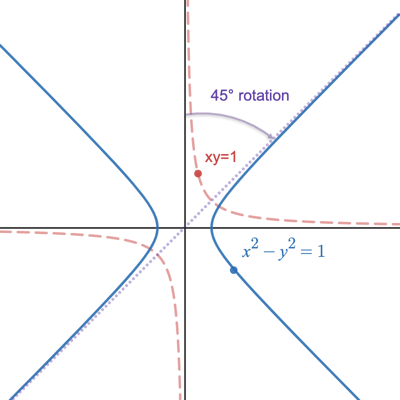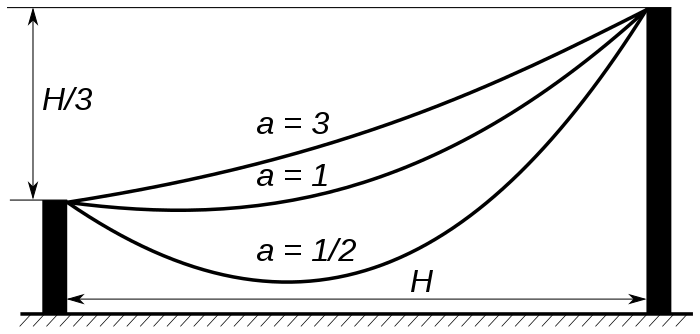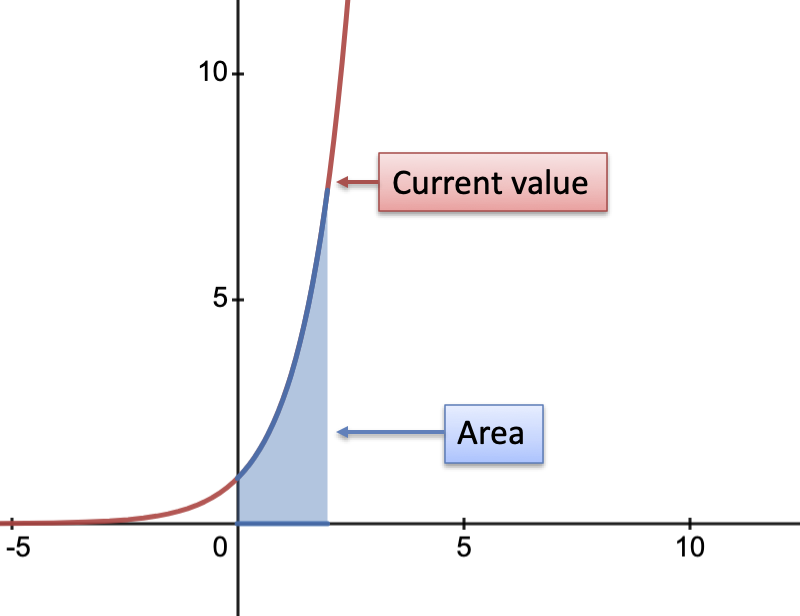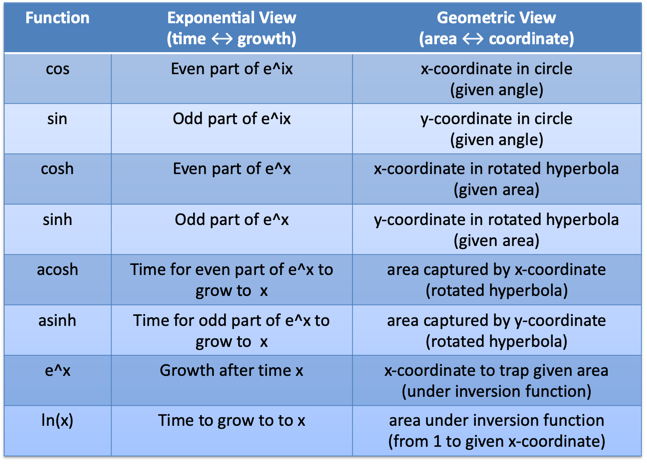Intuitive Guide to Hyperbolic Functions
The hyperbolic trig functions (, ) lived in a dark, musty part of my math attic. Typically, these are introduced with unsatisfying motivations ("Want yet another way to make a hyperbola? A catenary curve?"), or we see and crammed into tables of fancy integrals.
They weren't functions I could think with. What relationship do hyperbolas represent? Why are exponentials involved? Could I intuitively understand what "inverse hyperbolic cosine" actually does?
After much struggle, here's my summary:
- What are the hyperbolic functions? The even/odd parts of the exponential function that, funny enough, can build a hyperbola.
- Why are parts of the exponential called hyperbolic? That's the modern name. These functions are so darn good at making hyperbolas they're typecast for that role. (Similarly, sine isn't just about circles.)
- Why are hyperbolic functions useful? A better phrase is: Why are parts of useful? We now get partial versions of 's exponential properties.
- Ok, I'm ready. Why are exponentials and hyperbolas related? Hyperbolas come from inversions ( or ). The area under an inversion grows logarithmically, and the coordinates grow exponentially. If we rotate the hyperbola, we rotate the formula (). This requires modified logarithms and exponentials: the hyperbolic functions.
Still with me? Great. This guide aims to connect the exponential and geometric perspectives. (One answer to "What's the intuition?" is read a book; this is slightly shorter.)
We'll build on these insights:
- e is the process of continuous, 100% growth
- natural log is the time for to grow to a given value
- Euler's Formula connects with the circular trig functions
Time to dive in.
Intuitive Guide to Hyperbolic FunctionsPart 1: Exponential ViewpointBackground: Odd/Even FunctionsTaylor seriesEven and Odd ExponentialsPart 2: What do hyperbolic functions look like?Part 3: Applications of the Exponential InterpretationFunction equal to its own second derivativeUnderstanding Integral TablesNew descriptions of Sine and CosineNew Trig IdentitiesMachine Learning FunctionsPart 4: Geometric Viewpoint The Inverse Function Hyperbola (xy=1) The Rotated HyperbolaThe Secant/Tangent hyperbolaRevisiting Inverse FunctionsPart 5: Applications of the Geometric InterpretationThe CatenaryShape Where Arc Length = Area Hyperbolic GeometrySummaryReferences
Part 1: Exponential Viewpoint
Background: Odd/Even Functions
The number 13 can be split into an even part (12) and odd part (1). They combine to the whole: 13 = 12 + 1.
This even/odd split works for functions, too:
Functions are tricky to separate because they have multiple values. The separation we look for is between the future values () and the past ones ().
To see what the future and past have in common, take their average:
To see how they differ, take their average difference:
As a check, can we combine these parts to get the original?
Neat trick. We can split any pattern into even and odd pieces.
Taylor series
The Taylor Series (Math DNA) expresses a function as a polynomial:
The even exponents () are symmetric in the past and future (for example: ), and the odd exponents are anti-symmetric ().
Noticing this, we can get the even/odd parts of a function by grouping a function's Taylor series into even and odd exponents:
Even and Odd Exponentials
We have our even/odd split trick. Why not try it on the famous exponential function?
Instead of the awkward and , we label the even part (hyperbolic cosine) and the odd part (hyperbolic sine). The pronunciation varies.
Why the adjective "hyperbolic"? Well, Euler used the quantity without giving it a special name. Lambert later called them "transcendental logarithmic functions", and even later their ability to build hyperbolas was seen.
So, with our modern perspective, we label the even/odd parts of an exponential the "hyperbolic functions".
Call me a stubborn traditionalist: and are parts of , and are interesting for that reason alone.
Part 2: What do hyperbolic functions look like?
Let's graph and with its parent:
- is our standard exponential, with Taylor series:
- is a gentle bowl. It looks parabolic in the beginning, with Taylor series:
- looks like a line that starts to grow exponentially as the negative past recedes (). As the past recedes, it blasts off as well. The Taylor series is:
Now for a usually-confusing question: What does the parameter in really mean?
It's nothing special! It's the same in , the time the exponential function is allowed to grow: .
We can see the hyperbolic trig functions as:
- : What is the even part of after units of time?
- : What is the odd part of after units of time?
Again, is just the regular parameter we're used to feeing into exponentials. A few gut checks:
- What's ? At (aka ), we haven't moved from our exponential growth starting point (1.0). The average of future and past is 1. The average separation must be zero: .
- As time goes on, the future grows and the past () vanishes. The average value becomes , and the average difference becomes . For large , we'd expect .
Now, how about the inverse hyperbolic functions like acosh (also called or )? "Inverse hyperbolic cosine" sounds scary, but think of it like this:
- : How long until reaches value ?
- : How long until the even part of reaches ? This must require more time than , since we're only using the even powers in our exponential growth Taylor series.
- : How long until the odd part of reaches ? Similarly, this must require more time .
In the graphs above, and require more time (i.e., are above) the natural log.
Intuitively, the hyperbolic functions are just modified exponentials and logarithms:
- and are partial/delayed exponential curves, with interesting behavior near zero where the diminishing past still has influence.
- and are slower versions fo the natural log, and require more time to hit their target. It takes units for to grow from 1 to 3, but takes units for the even part of to do the same.
Part 3: Applications of the Exponential Interpretation
Since we're dealing with baby exponentials (those little cherubs!), we might guess and have interesting math properties.
Function equal to its own second derivative
is the function equal to its own derivative ().
Ok. And Sine and cosine are functions equal to their own fourth derivatives ().
First derivative, fourth derivative, that's a big gap. Is there anything in-between?
You bet. The hyperbolic functions equal their own second derivative ():
Unlike and , there's no awkward negative signs, just a toggle:
Neat. The hyperbolic functions are like "half exponentials" because they take two derivatives to return to themselves. This explains why they're all over calculus -- not because we care about the coordinates on a hyperbola!
Understanding Integral Tables
You'll see hyperbolic functions in tables of tricky integrals and derivatives:
Let's see the family resemblance without getting lost in the details. We have the standard relationship:
Since the hyperbolic functions are modified exponentials, we'd expect the derivative of to be a modified form of :
If is large, the "" becomes inconsequential, and the derivative is:
Ah! The derivatives of resembles that of , except for small where the +1 term has influence. Previously, I had no idea what the derivative of would resemble.
New descriptions of Sine and Cosine
Because even/odd parts combine to the whole, we can split up the exponential function whenever we want:
So, what if we plug in ? We'd get
But the famous Euler's formula, says this:
Whoa. The even (symmetric) parts and odd (non-symmetric) parts must be the same, which means:
We have another way to discover the circular motion that creates cosine and sine: by giving the real parameter to the complex exponential (), or giving an imaginary parameter () to the real exponential .
In sine's case, we have an awkward imaginary term to move around:
Intuitively, feeding an imaginary number into odd function, with odd exponents, seems like it should have leftover imaginary items, right? (For example, .) With an even function like cosine, the terms will become real after being taken to an even power ().
New Trig Identities
Who doesn't need a few more formulas in their back pocket? With some quick algebra, we can convert standard trig identities into their hyperbolic versions. Starting with:
We swap in and we get:
Now, the term is just a parameter. To simplify things, just say and write:
To convert a regular trig formula to its hyperbolic equivalent (Osborne's Rule), swap:
- (because of the when turning into )
Machine Learning Functions
While looking for applications of , I ran across this function, used in Machine Learning:
The direct interpretation will give you a headache: "Take the natural log of the x-coordinate in a hyperbola". What? Why would you do that?
The exponential perspective makes things easier:
- The natural log of the regular exponential function will just cancel, since . Functions like (or rather, the absolute value ) don't have a clean derivative at zero.
- However, resembles the exponential function. When we take its natural log, we get something resembling . The function is a parabola near zero and becomes a line as we move away:
How does this work? For small :
- . These are the first few terms of its Taylor series.
- . The time to grow from 1.0 to 1 + .01 at 100% interest is only .01 units (not enough time for compounding)
- Combining the approximations, we get: .
As increases, we approach an offset line:
Cool! We have a parabola-line hybrid. There's no hyperbolas involved: we're treating as a modified exponential.
Bonus: Lining Things Up
We can try to get to approximate instead of the offset line . We just need to add a term that counteracts the :
Notes:
- Our new function (purple) still looks like a parabola for small .
- The in the in makes the function symmetric.
- Adjusting the constant changes how fast we approach the line .
Hyperbolic Tangent
Another function used as an activation function is the hyperbolic tangent:

What's the meaning? It's the ratio between the odd and even parts of the exponential function at a given moment.
- At , the even part dominates (full symmetry between past and future).
- As grows, the odd part catches up, and the balance approaches 1 (equal parts symmetry and anti-symmetry).
The function is nice because it's centered at 0 and smoothly varies between -1 and 1. Remember, as increases, and .
Again, is best seen as a ratio of exponentials, not hyperbolic coordinates.
Part 4: Geometric Viewpoint
Ok. We've made it pretty far without actually talking about hyperbolas.
Hyperbolas confused me for a while: they aren't an everyday shape. What are they really used for? Catenaries? Orbital mechanics? That isn't a general-purpose pattern.
Most sources trot out graphs like this:

Yikes. Time to build an intuition.
The Inverse Function Hyperbola (xy=1)
Hyperbolas are built from inverse functions, like . It's a simple, useful relationship: what's the inverse of ? . Multiply them and we undo all scaling: .
To find the area under the inverse curve, we need:
Where
- specifies the boundaries. We start at and go to some upper value for . (We can't start trapping area at , since it shoots up to infinity.)
- is the area we collect at each x-coordinate as we march along
This integral is hard. Thankfully, one definition of the natural log is:
so we have a ready-made solution. Starting from , what upper x-coordinate will trap 5 units of area? We want to solve:
Which means
Wow! That's a large coordinate to trap 5 measly units of area.
In general, we have
And the y-coordinate (inverse) at that position is .
The Rotated Hyperbola
There's multiple ways to make a hyperbolic curve. If we rotate 45 degrees, we get something like this:

How do we rotate the equation ? Using a rotation matrix:
We can define a new axis rotated from the original axis:
For a 45-degree rotation, we have , and get:
Next, we draw a hyperbola on this new axis using our inversion relationship:
Now we have a rotated hyperbola, but aren't that interested the new axes: we want the new curve along the original axes. So, we convert and back to and :
Ah! Almost there. Our original hyperbola () contains the point , which is a distance of from the origin. If we scale down by this radius, we can get the unit hyperbola, which is a distance 1 from the origin:
Ok. Time for the scary diagram:

We have our rotated hyperbola, and want to trap units of area (the full includes the bottom half of the diagram). What functions determine the coordinates?
It turns out the even and odd parts of the exponential function solve this puzzle, and . There's a 1950's pamphlet "Hyperbolic Functions" by V. G. Shervatot, that goes through the derivation. The key is realizing that hyperbolas (whether rotated or not) trap area logarithmically, and the corresponding coordinates grow exponentially:
hyperbola (area under curve):
hyperbola ( per diagram)
In case it needs to be said: it's not obvious that the even/odd parts of the exponential function determine the coordinates that trap area in a rotated hyperbola.
(Note: Hyperbolas can also be defined in terms of distance, not inversion, but that doesn't hint why exponentials should be involved.)
The Secant/Tangent hyperbola
Another confusion was why we needed more functions to parameterize the hyperbola, when existing trig functions do the trick:
- Start with a circle
- For any angle , we have coordiantes =
- If we invert the x coordinate (hey, it's what hyperbolas do), we get
- If we scale the y coordinate by that same inversion, we get
Does this really make a hyperbola? It meets the requirements:
(relationship needed for rotated hyperbola)
(rearrangement of the famous )
This video shows how the various parameterizations behave (open the calculator):
Our familiar trig functions ( trace the same hyperbola as the fancy new . They just go a different speed. And the parameter is just an everyday angle we plug into trig functions.
Although there are multiple parameterizations for the hyperbola, and are defined with exponentials and are the analog of and . They can wear the Official Hyperbolic Parameterization crown.
Revisiting Inverse Functions
The inverse hyperbolc functions go from coordinates back to area. Let's say I'm on the unit hyperbola, with an x-coordinate of 5. How much area have I trapped? .
The inverse functions sometimes are called ("area hyperbolic cosine"). This forces us to think about the coordinate-to-area conversion. Again, I prefer to think about a generic exponential, and prefer ("inverse hyperbolic cosine"). Area is one interpretation, don't force me into it.
We can derive the formulas for the inverse functions by solving :
These look like modified logarithms, not area-finding functions.
Part 5: Applications of the Geometric Interpretation
The Catenary
The main application of the geometric view is that the is the shape a rope takes when hanging between two fixed points. It's not quite a parabola, it's a catenary curve. All of these hanging ropes (source) follow :

The idea here is fairly subtle:
- First, create a rotated hyperbola with
- Instead of using the hyperbola, make a graph of just the x-coordinate.
- This graph of just the x-coordinate makes a new curve, which models how the rope hangs
This convoluted process isn't how was discovered. No, there's a differential equation that models the forces inside a hanging rope:
To solve the differential equation, we need the convenient exponential properties of , and wind up with:
It's cute that also parameterizes a hyperbola, but that had nothing to do with the solution.
Shape Where Arc Length = Area
The area under the exponential equals the current value (plus a constant). Consider the region from to :

- Area under curve:
- Current value:
- Pattern:
A pretty clean connection, right? (Don't forget that )
Now how about ?

- Current value:
- Area under curve:
- Arc length of curve:
- Pattern:
The current value of can be swapped in using the identity .
For large , the is negligible and . So, for large , we get equality between area, arc length, and current value (imagine the green rope hanging down and just touching the x-axis). It's more connected than regular , not bad!
(Intuition for another day: Math deals with abstract quantities, not units. is not directly comparable with . Yet in math class, we can solve and nobody cares that constant, linear and squared terms are used in conjunction.)
Hyperbolic Geometry
The shape of the universe may be a hyperbola, and hyperbolic geometry is used in special relativity (beyond my pay grade). If we do live in a giant hyperbola, I, uh, may be forced to recant my "exponentials first" stance.
Summary
The hyperbolic functions can be seen as exponential (relating time and growth) or geometric (relating area and coordinates). Hyperbolas, whether rotated or not, have logarithmic area and exponential coordinates.

It's been a long journey, but these functions don't haunt my attic any more.
Happy math.
References
- Even/odd functions
- Various Hyperbolic Relations
- History of Hyperbolic functions (pdf)
- Osborne's Rule
- Hyperbolic Functions Book
- Geometric derivation of hyperbolic functions